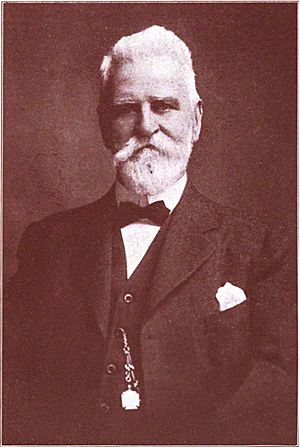James Clark Strong facts for kids
James Clark Strong (born May 26, 1826, died 1915) was an important American. He was a general in the American Civil War. After the war, he became a well-known lawyer in New York. Strong was a strong supporter of Native Americans. He worked hard to help the Cayuga and Seneca tribes. He fought for their land rights in court. These were some of the first cases about Native American land ownership in New York.
Contents
Early Life and Family
James Clark Strong was born in Phelps, New York in 1826. He lived in the Washington Territory from 1847 to 1856. Strong married Emily K. Strong. They had three children: Jean, Edward, and Stuart.
Serving in the Civil War
Strong fought for the Union side during the American Civil War. He rose to the rank of lieutenant colonel. During the war, Strong was badly wounded. This injury caused him to have a permanent limp. After the war ended, he was honored with the rank of brigadier general.
Strong was the leader of the 38th New York Volunteer Infantry Regiment. He ordered his unit to leave service on June 22, 1863. This happened in East New York, Brooklyn.
Political Views and Support
Before the war, Strong was a member of the Democratic Party. After the war, he became a key member of the Republican Party. Strong was a big supporter of Ulysses S. Grant. Grant was a famous Civil War general who became president.
Strong was against Horace Greeley, who ran against Grant. Strong wrote a well-known letter. In it, he asked other war veterans to support Grant's re-election. This was for the 1872 United States presidential election.
A Career in Law
After the war, Strong joined his brother's law firm. His brother, John C. Strong, was also a lawyer. Their firm was in Buffalo, New York. People saw Strong as an important lawyer. He was also a respected citizen of Buffalo.
Strong didn't write much about his law practice in his autobiography. He wrote about returning to Buffalo in 1866. Then he jumped to 1892. In 1892, he traveled to England. There, he gave talks about the North American Indian.
Strong wrote a book in 1893. In it, he shared his feelings about Native Americans. He believed that people should be fair and kind to them. He felt it was important to fix the past wrongs done to them. He wanted to remove the "stigma of inhumanity" towards Native Americans.
Helping the Cayuga Tribe
Strong represented the Cayuga people who lived in Canada. They had a claim against New York state. They said the state had not paid them money promised in a treaty since 1809. The Cayuga tribe believed they were owed a lot of money. This amount was between $400,000 and $500,000.
The state's Board of Claims rejected their request. Strong tried to get the courts to help. But the New York Court of Appeals also said no in 1885. The court decided that the Canadian Cayugas were not part of the original treaty.
Supporting the Seneca Nation
Strong also represented the Seneca Nation of Indians. They were trying to get back land. This land had been sold a long time ago. The Seneca Nation argued the sale broke a law called the Nonintercourse Act. This law said that only the federal government could approve land sales with Native Americans.
The New York Court of Appeals rejected the Seneca Nation's claim. The court said the federal government had quietly agreed to the sales. They also said that states, not the federal government, could end Native American land rights. The court also said the lawsuit was too late. The U.S. Supreme Court agreed that the lawsuit was too late. So, they did not hear the case.
Later Years
Strong moved to Los Gatos, California in January 1896. He published his autobiography in Los Gatos in 1910.


